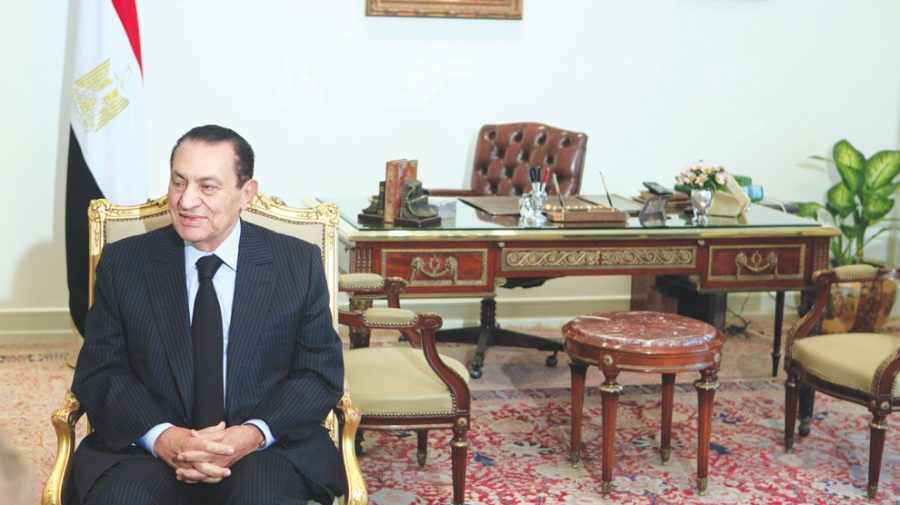December 17, 2010 – A Tunisian street vendor named Mohammed Bouazizi sets himself on fire in Sidi Bouzid, Tunisia, after his wares are confiscated by local police officials and he is publicly humiliated by a police officer. Outraged by these events, the citizens of Sidi Bouzid begin violent protests that soon spread to the nation’s capital, Tunis.
January 14, 2011 – The Tunisian president, Zine El Abidine Ben Ali, flees the country after 28 days of violent protests against his government. The fall of Ben Ali sparks widespread uprisings throughout the Arab world. Major political demonstrations begin in Algeria and Yemen, and minor protests are soon seen in Libya, Jordan, Mauritania, Sudan, and Oman.
January 25, 2011 – Nationwide protests inspired by the Tunisian revolt begin in Egypt against the government of Egyptian President Hosni Mubarak. Roughly 45,000 protestors gather in Cairo alone, in addition to thousands more in various cities throughout Egypt. The protests are generally non-violent, but there are reports of some casualties by both civilians and police.
Mubarak had been president of Egypt since 1981 and during that time played a pivotal role in the history of both his nation and the entire Middle East. The stability of his regime was for 30 years a cornerstone of United States policy regarding the Middle East, but since the Egyptian presidential elections of 2005, Mubarak’s rule had come under increasing pressure from various sources of opposition within Egypt. The 2005 elections were widely viewed by political commentators both within and outside Egypt to be illegitimate, and this fact combined with the perceived lack of economic and political opportunity in the country was a major source of opposition to Mubarak’s rule.
January 28, 2011 – The “Day of Rage” protests begin in Egypt. Shortly after Friday prayers, hundreds of thousands of demonstrators gather in the streets of Cairo and other Egyptian cities to protest against the Mubarak regime. Opposition leader Mohammed ElBaradei travels from Giza to Cairo to participate in the protests. Some looting is reported, and the Egyptian government orders the military to assist police in maintaining order. International fears of extensive violence in Egypt grow, but no major casualty numbers are reported.
January 29 – 31, 2011 – Protests throughout Egypt continue as the military increases its presence on the streets of Cairo. A curfew is instituted along with a threat of violence should it be violated, but protesters continue their vigil throughout the night. The military shows restraint in its use of force, reportedly refusing to obey orders to use live ammunition, and once again there are no reports of major casualties.
February 1, 2011 – After another day of nationwide unrest, Mubarak addresses the people of Egypt and offers several concessions to the protesters. In addition to proclaiming that he would not run for another term and promising various political reforms, Mubarak also set September 2011 as the general date for the next set of elections. He also said that he would stay in office to ensure a peaceful transition. Pro-Mubarak and anti-Mubarak groups begin to meet in small but violent clashes throughout the night.
February 2 – 4, 2011 – Violence escalates as Mubarak supporters continue to flood the streets and come face-to-face with anti-government protestors. Violence toward international reporters and news agencies escalates, as well, prompting many political commentators to suggest that the violence was the result of direct action by the Mubarak government to end the protests. Greater bloodshed continues to be prevented by the military, however, which constantly moves to separate anti-Mubarak and pro-Mubarak groups. President Mubarak, in interviews with various news agencies, continues to refuse to step down.
February 5 – 10, 2011 – Protests in Cairo’s Tahrir Square and throughout the nation continue unabated. Countering claims that the protests are the brainchild of the Muslim Brotherhood, a political opposition group begun in Egypt with transnational connections to a variety of Islamic organizations, Egyptian Christians hold a Sunday Mass in Tahrir Square protected by a circle of Muslims.
Negotiations begin between Egyptian Vice President Omar Suleiman and opposition representatives as the Egyptian army takes on a larger security role throughout the country, including the protection of Egypt’s various archeological treasures. The Mubarak government adopts a mixture of concession and defiance as Suleiman offers various political and constitutional reforms while other members of the Mubarak government accuse other nations, including the United States, of meddling in Egypt’s affairs.
On February 10, Mubarak once again formally addresses the citizens of Egypt amid reports of a possible military coup, but instead of the resignation expected by the protesters, Mubarak states simply that though his powers would be transferring to Vice President Suleiman, he would remain in Egypt as its head of state. Shock and then anger rips through the crowds of protesters listening to the speech, and demonstrations begin to escalate in number and intensity throughout Egypt.
February 11, 2011 – Massive protests in response to Mubarak’s speech continue in a large number of Egyptian cities. At 6 p.m. Cairo local time, Vice President Suleiman announces that Mubarak had resigned his presidency and that the Supreme Council of Egyptian Armed Forces would assume leadership of the country.
February 12 – 13, 2011 – The Supreme Council of Egyptian Armed Forces dissolves Egypt’s parliament and suspends its Constitution. The council also declares that it will hold power for six months or until elections can be held. ElBaradei, a key opposition leader during the protests against the Mubarak government, urges the council to provide more details to the Egyptian people regarding its plans for the country. Major protests end for the short-term, but much uncertainty regarding Egypt’s future persists.
Reporting was gathered through the Associated Press.







